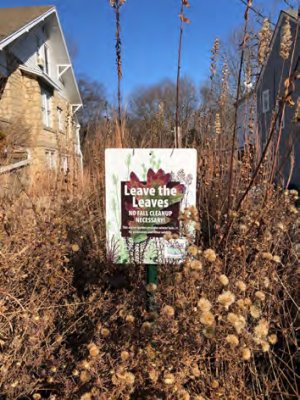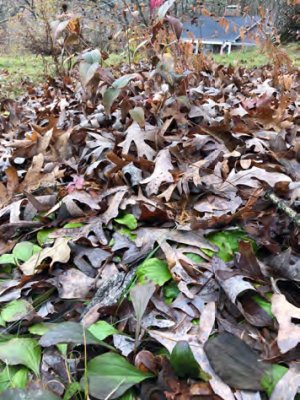AgEBB-MU CAFNR Extension
Green Horizons
Volume 25, Number 1
Winter 2021
Leave the Leaves
Carol Davit, Executive Director, Missouri Native Foundation
 |
The "Leave the Leaves" garden sign, manufactured in Missouri, is available for sale through the Grow Native! program. |
"Fallen leaves and spent stems provide important shelter for native bees, snails, salamanders and more in forests, woodlands, and yards."
Through the mastery and mystery of plant chemistry, leaf abscission occurs every fall in Missouri's woodlands and forests, and petioles detach from deciduous tree and shrub twigs, sending cascades of colorful leaves to the ground.
Hiking through Missouri with crunchy leaves underfoot is an annual delight. We value neighborhoods with lots of trees-but instead of enjoying those fallen leaves at home, we tend to go into "yard cleaning" mode as soon as they hit the ground.
Why? Because many of us live in houses with trees on our properties, but with lawn underneath them instead of a woodland or forest floor. A light layer of leaves shouldn't hurt your lawn, whereas a heavy layer of leaves can damage or even kill turf-but are leaves the problem, or is it all that lawn?
Lawns are the perfect vegetation to withstand foot traffic: they are ideal for playing ball in the yard, and perfect venues for barbeques or other outdoor events. If you use your yard for these activities, by all means, leave the lawn where you use it. But for other areas of your property, if the only time you are on your turf grass is to mow it, consider "losing the lawn" and instead, "leaving the leaves."
 |
Fallen leaves in native plant beds provides |
Converting areas of unused lawn into beds of native wildflowers, grasses, and sedges, as well planting more trees and shrubs, will improve the ecological functionality of your yard and make it more interesting. And when leaves fall in these areas, you can leave them be.
As in forests and woodlands, fallen leaves in yards provide year-round habitat for snails, insects, and salamanders, harbor moth cocoons, and shelter and feed many other animals. Snails are food for birds-snail shells provide birds with calcium, which is important for strong bird eggs. Salamanders need insects for food. Moths pollinate plants. In other words, nature isn't alive only in spring and summer, but year round, and fallen leaves and other spent vegetation in your yard are important to nature's web of life.
Resisting the urge to cut back the stems of grasses and wildflowers at the end of a growing season will also benefit many species. Leaving seedheads and plant structure throughout winter provides food and shelter resources for many creatures and gives people opportunities to observe nature up close. In the dormant season, leaving spent stems of native grasses and wildflowers standing throughout the winter not only gives vertebrate animals shelter, but the stems also are hibernating places for native bees.
If you trim your native garden or landscaping in late winter or early spring, instead of cutting all spent vegetation to the ground, leave some 8- to 22-inch tall stems to provide nesting areas for stem-nesting native bees. Bees develop in these stems over the course of a year. New growth will hide the stubble.
